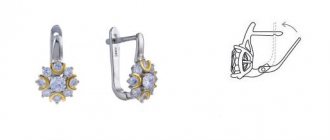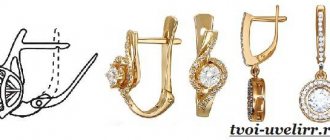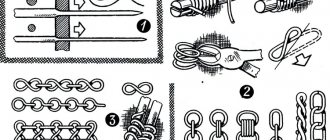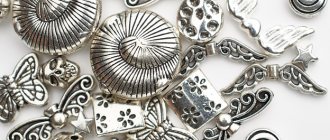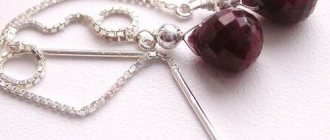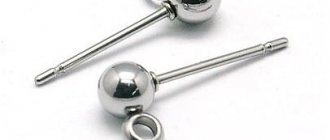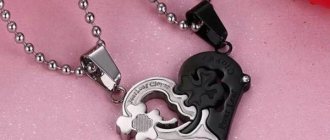Lock and fasten – the purpose of this fitting element can be heard already in its very name “lock” or “fastener”. However, in addition to opening closed and fastening detachable jewelry, such as a necklace or bracelet, clasps for jewelry often take on additional functionality. They become part of the decor, help to vary the size, position the product in the desired plane or distribute its weight so that it is comfortable to wear and durable. To do this, just choose the right lock and suitable clasp. How to find the right option among the many offered? We will talk about each individual representative of the set further.
Spring lock
Let's start with one of the most common clasps used in jewelry. The name comes from English. “Spring ring clasp” - translated into Russian: “clasp with a spring ring.”
The lock is a hollow, slightly open ring in which a spring latch, controlled by an external lever, moves. Just move the lever and the lock will open. And if you release it, the latch will return to its original position, that is, the arc-shaped pin moving inside the ring will close the circle, filling the gap formed when opening. The loop of the lock mate freely fits into this gap, where it is held in place by a pin.
These locks are available in various sizes and colors. They are considered quite universal, although they have contraindications. Among the advantages of a spring lock:
- Wide selection of sizes, colors, coatings;
- Versatility - the lock has a neat round shape and relatively small size and easily fits into the style of any decoration;
- Reliability – despite its small size, a working lock eliminates the possibility of accidental opening;
- It can be used with an extension - the sliding ring of the lock will just as well close on a chain link of a suitable diameter, thus, a piece of chain delivered to the right place will help adjust the size of the product;
Among the disadvantages of a spring lock:
- Not the most convenient for fastening with one hand, although it is used on bracelets;
- Often requires auxiliary connecting fittings;
- The internal miniature spring of the lock often fails. For a lock made of an expensive alloy, expensive repairs with replacement of the spring are possible. It’s easier to throw away an inexpensive lock and replace it with a new one.
Use of clasps for bracelets in handmade
As a rule, all the clasps we offer are used for bracelets made of beads, beads, leather, ribbons and other decorative materials.
The mechanics of all locks are time-tested: they are light and easy to use, and in the closed position they reliably fix the bracelets in a fastened state. Many of them can be installed on wide chains and certain types of necklaces.
Often gold and silver bracelet clip clasps are used as watch clasps.
Carabiner lock
Another acquaintance from the jewelry arsenal is a carabiner lock, a crab (lobster) lock, as it is also called. Its design really resembles the claw of a marine arthropod. And it is also equipped with a spring latch: But if in the previous case we were dealing with an arc pin driven by a lever and a spring:
Here the lever acts: when you press on one side, the other, rising, releases the gap, and the spring returns the lever to its original position.
Compared to a springel lock, a carabiner lock is more bulky and massive. That is why it can withstand heavy weight loads. The advantages of a carabiner lock:
- Due to the enlarged design, it is easier to control with one hand, therefore it is more convenient to use in bracelets;
- You can independently replace a worn-out spring with a new one (for disassembling and assembling a simple lock design, an engineer’s diploma is not required; ingenuity, observation and skill are enough);
- It is possible to use an extension chain;
Of the minuses:
- Due to the same bulkiness, the lock in the product is more noticeable.
- From sharp jerks and loads exceeding the recommended one, the lock loop is deformed, a gap is formed between it and the moving lever, which is fraught with the risk of the return ring slipping out of the “crab claw”, which means losing the decoration.
At the same time, the first of the minuses is very conditional. Manufacturers have long learned to decorate large carabiner locks, giving them fancy shapes. Like this, for example:
And beauty – it remains beauty even in large sizes!
Carabiner – strong and durable
This type of lock is also known as “Hook buckle clasp” and “Lobster claw”.
The mechanism looks like a hinge, one side of which is replaced by a moving bracket. To open it, you need to press the spring-loaded latch, so the connecting ring attached to the carabiner can almost never fall out. Compared to spring locks, such locks can withstand more weight, and they are also more convenient to use. Carbines are assembled by hand, so another advantage is the ability to repair damaged products and replace worn springs. Therefore, if you are planning to buy a silver bracelet, give preference to models with a similar clasp.
The only caveat is that sometimes you need to inspect the structure. Sharp jerks deform the lock hinge, creating a gap between this part and the movable bracket into which the connecting ring can slip.
Screw lock
The detachable lock, consisting of two parts, is equipped with an internal thread, which connects its two parts together, simultaneously closing the edges of the jewelry. The design of the two-part body of such locks, as well as the color scheme, are varied, but the base is always a cylinder: screwing in a spiral without a circular cross-section is impossible.
Advantages of a screw lock:
- High reliability: screwed and tightened all the way (without fanaticism, the thread can be broken), it has virtually no chance of unauthorized opening;
- Resistance to breakage: there is simply nothing to break in the lock. If the alloy from which it is made is of high quality, the lock will serve forever.
However, there are also disadvantages:
- Used for fixed size jewelry only.
- Twisting and unwinding takes time. So the castle is not for those who always have no time.
- It is possible to twist it with one hand, but this will require a lot of practice, so choosing such a lock for a bracelet is not the most reasonable decision.
- A screw lock without movable, 360-degree rotating adapters is contraindicated for multi-row jewelry: during the process of tightening the lock, they can get tangled.
Clasp requirements
It is the lock that bears the greatest load during operation. And by attaching additional pendants to the bracelet or putting a pendant on the chain, you almost double it. Because of this, the fragile mechanism can weaken, become deformed, or even burst. Therefore, when purchasing an accessory, make sure that the clasp meets the following requirements:
- the lock must be as tight as possible, while its parts must move smoothly, without hesitations or jerks;
- the accessory looks more presentable when the appearance of the mechanism is harmoniously combined with the design of the product itself;
- the fastener should not have sharp corners, nicks or unpolished edges that could scratch the skin;
- latches that open with one hand are more convenient and practical to use.
All bracelet locks must meet these standards. But now jewelers have developed many varieties of clasps, differing in configuration, size, and quality. Read about their advantages and disadvantages below.
Hook closure
A hook is the simplest of closing devices. A hook fastener always has a bend, at least at one end, suitable for hooking something. In the case of a clasp for jewelry, the hook engages a loop that is appropriate in size and this is sufficient to close the jewelry into a circle and hold it. Most often, a clasp with a hook also comes with a loop, but this is not necessary.
Please note that the hook clasp is available in several versions:
- Regular hook - there is one hooking bend of some shape;
- S - shaped hook - has two bends on both sides and both are capable of hooking and holding: for a double-sided hook, two loops are respectively required. Such a fastener, by and large, does not require permanent fastening. It can serve several decorations in turn.
- Two-component - in addition to the hook itself, the kit also includes a loop for it.
- One-component - a loop is not included in the kit, there is only a hook and the manufacturer offers to decide for yourself which holding element to hook it to.
The smoothness and angle of bending, sizes, and decor of hook fasteners are varied. When choosing, you should pay attention to the quality of the alloy. Excessive fragility can cause the hook to break, and excessive malleability can lead to its extension. The hook has no additional insurance, which is why it is the simplest. So don’t be shy, before buying a hook fastener, be sure to touch, feel, examine, try to hook and pull.
And further. The hook is designed for heavy jewelry. Under the weight of the product, the hook does its job properly. Fastening, at the same time, with one precise, light movement.
Among the advantages of the hook:
- Simplicity - remember, the simpler the design, the less likely it is to break;
- Easy to fasten;
- Large selection of styles and decor;
- Can be used with an extension chain;
The disadvantages include:
- Low reliability: unfastens as easily as fastens;
- It is absolutely not suitable for elegant light jewelry: firstly, the hook is a rather large clasp, and secondly, as mentioned above, on its own, without the counteracting force of gravity of the jewelry, it does not work;
Hook lock
Jewelry with this clasp option also has a teardrop shape. Products with such fastening are easy to put on and take off. As an advantage, it is worth noting the huge number of variations in the implementation of such a lock. It comes in any shape, made of plastic, wood or metal. The negative point is that it is unreliable and the decoration is easy to lose.
How to make a clasp on a bracelet with a hook? To do this, each part of the lock has holes for gluing a cord, as well as small loops to which a chain or textile, or a clamping part, clings. When connecting, you can add a cord with decorative elements - large beads, key chains or plant figurines. The ends of the bracelet are inserted into the hole in the lock and then clamped using a special device.
Toggle Castle
Translated from English, “toggle” means “toggle switch,” “switch,” “crank lever.” Due to its external similarity, the same word is usually used to refer to an oblong wooden button: a kind of lever with an eye for sewing. Inserted into a loop, it closes the detachable elements of textile or leather products. The toggle lock works the same way.
A toggle lock is often two-component: it consists of a T-shaped part and a return loop. The degree of decorativeness of both components of the lock varies. Manufacturers allow you to choose cast minimalism that is not burdened with decor:
Or a fancy sculptural composition:
But at the base of the toggle there is always the same button that easily fits into the loop longitudinally and locks in it when turned across. The diameter of the return loop is always less than the length of the T-arm. This is what ensures the fixation of one component of the lock in the arms of the second.
Among the advantages of the toggle castle:
- Easy to fasten: easy to manipulate the lock even with one hand;
- Wide choice of design and style;
- Each of the components of the toggle lock can be used for purposes other than its intended purpose: a pendant, a sinker - whatever your imagination allows you to do.
There are also disadvantages:
- The lock is always large: manipulation with a small one is simply inconvenient;
- A large lock, especially one with rich decor, is very eye-catching; it subordinates the style of the product and it can be difficult to select for it the entire set of accessories necessary for assembly, so it is recommended to buy everything at once.
- Incompatible with light jewelry: like a hook, in addition to its own hooking abilities, a toggle lock needs a solid counteracting force.
- If positioned incorrectly, it can also enter into unnecessary resistance with large heavy elements of the product, which move the “button” out of place, unfastening it at the most inopportune moment.
Pin lock
Having heard such a name, it is difficult to imagine how the product is fixed. In fact, the lock looks almost the same as magnetic rectangles. The only difference is that on one side there is a small pin with a thread, and on the other there is an inlet hole.
At first, the lock closes and opens with effort, but after some use the process becomes noticeably easier. How to make a clasp on a pin bracelet? It is attached in the now familiar way: by gluing it to the base of the product. It is worth noting that this type of lock is most suitable for men's bracelets or those made in a classic style.
There is an even simpler version of the pin. A ring is attached to one side of the jewelry, and a horizontal pin is attached to the other. The lock is fastened by threading the second part into the hole.
Box clasp
It is also a fastener-Box (from the English word Box - box). A two-component detachable box fastener consists of an upper decorative part in the form of a round, rectangular or other miniature, often richly decorated, box and a tongue inserted inside. There are several systems for the tongue and its fastening inside: most often it is a pedal bent from a thin metal plate:
But there are options with additional insurance, or even with a hook pressed on both sides. But the operating principle is always the same. To close the lock, you need to insert the inner part into the box until it clicks, and to open it, you should press on the antennae or ears protruding outwards, which, when pressed, also compress the pedal (hook), allowing you to free yourself from the retaining grooves.
Advantages of a box lock:
- Increased reliability: the locking system almost completely eliminates the possibility of accidental unfastening;
- Decorative;
- Versatility: a box of a suitable size is suitable for elegant and large jewelry;
This type of fastener has no obvious disadvantages, with the exception of the relatively high price and the decor that dominates the entire product. However, as with everything, there are limitations. Thus, it will not be possible to use a box lock in conjunction with an extension cord. If you have the skill, it is possible to manipulate the clasp with one hand, but it is more difficult to unfasten it than to fasten it, so it is recommended to practice before putting it on the bracelet.
Box lock – for heavy jewelry
Box clasps, or “Box clasps,” look like two pieces of a puzzle—a latch—a strip folded in half, with several protrusions at the tip—is inserted into a square or rectangular hollow piece with a hole.
Placed in a box, it is held inside by these notches, and when the jewelry needs to be unfastened, the bar is simply compressed so that it becomes flatter and easily slides into the gap. Sometimes the mechanism is equipped with additional fixing loops (they make the structure more reliable, but can cling to clothing) or its shape is changed. This type of fastener is less common than carbines and spring locks, primarily due to the complexity of their manufacture. But they fit perfectly into the overall design of the accessory, without disturbing the overall harmony of the lines. Therefore, only the most exquisite and expensive silver jewelry is equipped with such models. And also because the box lock can easily withstand significant loads, they are placed on massive necklaces and wide bracelets with large links.
Folding clasp (butterfly, buckle)
The action of the fastener is based on a hinge, which allows the flat elements fastened by it to be unfolded and folded, like a book. A butterfly clasp can be detachable: the folding mechanism simply engages a response element, such as a loop inserted into it. It is also one-piece: the mechanism releases or captures the clasp links superimposed on each other, thus lengthening or shortening the product so that it can be, for example, unfastened by pulling it through the hand, and then fastened, ensuring a fit to the wrist.
Advantages of a folding clasp:
- Reliability and quality: used on expensive jewelry, for example, watches, because the mechanism is a full-fledged design, time-tested, moreover.
- If you have the skill, it can be easily fastened with one hand.
Flaws:
- Bulky, does not fit into every style;
- It comes unfastened when the folding “lid” is accidentally pulled or caught.
- It wears out in use.
How to make a clasp on a beaded bracelet on a machine
For a beadwork woven using a special device, a ribbon clip can serve as a lock. Before attaching it, both edges of the bracelet are secured with threads or thin fishing line. Then each is inserted into clamps, which are squeezed with pliers until they hold tightly.
The loops on the lock can be connected with a lock, ribbon, carabiners or a pair of pins. Clamps can be purchased ready-made or made on a machine yourself.
Making your own bracelet guarantees its uniqueness. In the process of work, you can show your imagination, creativity and creativity, use any materials you like, and choose a design taking into account your personal style. And the original clasp, corresponding to the style of the product, will add originality to it.
Slider clasp
A detachable two-part fastener consists of two tubes with different cross-sections. They are fastened together by inserting the smaller one into the larger one. Often the slider fastener is equipped with an additional fastening: a latch or a magnet. This specialized clasp is designed for multi-row and wide decorations. The length of the fastener, as the number of fastening loops on both its parts, is determined by the width of the decoration or the number of rows in it. Instead of loops, the slider may have grooves, grooves, a clip for attaching ribbons, braids, or flat weave fabrics.
Advantages of the clasp:
- Withstands heavy jewelry, but is also suitable for light ones, since its effectiveness does not depend on the weight of the product;
- Easy to fasten and unfasten even with one hand;
- Wide range of sizes: it is possible to choose according to the width of the product.
Disadvantages:
- Fragility: without additional fastening it wears out, becoming unreliable. And their presence increases the likelihood of breakdown: the magnet is demagnetized, the latch spring is stretched.
- Long connection: each fastening loop requires special attention, and there can be more than a dozen of them.
- For fixed size jewelry only.
Magnetic mount with hook
This type of lock is very popular among bracelets of various models due to its ease of use and originality. A magnetic lock with a hook can be deliberately long or, on the contrary, miniature, made in brass, gold, bronze and silver. Its use in the stylistic design of a product can significantly improve the appearance and give it a unique charm. This is a very simple solution, so it’s worth decorating it with some addition in the form of a lush flower, a few strings of beads or beads.
Magnetic clasp
The detachable two-part clasp is closed thanks to the force of a magnetic field. At least one of its parts (and often both) has a regular magnet built into it, which attracts one part of the fastener to the other, holding them together.
The shapes and decors of magnetic clasp housings are presented in abundance on the jewelry market. As is the case with other types of locks, it is possible to find a discreet, extremely laconic clasp. And it is possible to give preference to one studded with rhinestones, which can become the most elegant detail of the decoration.
The advantages of a magnetic clasp include:
- Instant fastening without effort: convenient for bracelets that require dexterity with one hand, convenient for people with low vision and people with poor fine motor skills.
- A variety of fastening systems to the product, shapes, decor;
- Fracture resistance – there is nothing special to break in a high-quality magnetic fastener.
The disadvantages are:
- Applicable only to fixed size products;
- The strength of the magnet limits the maximum weight of the jewelry: if the weight is more than the magnet can hold, the clasp becomes useless.
- It is magnetized not only to its other half, but also to everything random: watches, buttons - everything that has magnetic properties.
- May cause harmful interference to the operation of some devices. Thus, people with implanted cardio- and other stimulators treat magnets with great caution.
- The magnet, no matter how powerful it is, sooner or later becomes demagnetized, and the fastener ceases to cope with its task.
Let us add that the magnet often acts only as an auxiliary holding force. Thus, a slider clasp can be equipped with a magnet, or a magnetic clasp also has a rotary lock for reliability.
Magnetic rectangle locks
Most women have seen this type of lock, as it is often used to secure bracelets, wallets, clutches and other haberdashery items. You can purchase such a retainer at any store of the relevant goods.
Let's look at how to make a clasp on a bracelet from magnets:
- Classic bracelet regaliz. Beads, rings, charms and other decorations are strung on a leather strap. Then a very thin layer of glue is coated on the inside of the lock and glued to the cord. It is important to maintain a balance here, because if there is too much glue, it will squeeze out and the product will look untidy.
- Bracelet with braided cords. Regaliz fittings can be combined not only with cords, so you can safely choose other, most suitable materials. The lock is coated with a thin layer of glue and one or more braided cords are inserted into it, depending on their thickness or diameter. Then, if desired, decorative parts are threaded through or dispensed with and the lock is glued in a similar way on the opposite side.
To decorate such a clasp in an unusual way, you can insert a decoration on a chain with an original keychain into it along with the end of the bracelet.
Snap closure
The clasp is used not only for jewelry, but also for fastening items of clothing, accessories, etc. The button clasp, adapted for jewelry needs, differs from its counterparts only in the way it is attached to the product: instead of sewing loops or holes, it has fastening ones, those that can be attached not with stitches of thread, but with connecting rings.
The principle of operation of a detachable two-component fastener-button is still the same: one part is equipped with a hole or recess with a ring fastening, the second with a protruding element held inside the hole or recess. To fasten it, just align both parts of the fastening and press until it clicks. To unfasten, pull with force, overcoming the force of the ring fastening.
The advantages of this fastener:
- Easy to fasten, even with one hand;
- Many options for sizes and decor;
Among the disadvantages:
- The ring fastening wears out during use;
- Fastening with one hand is easier than unfastening;
- Cannot be used with extension chain.
The button can be magnetic, that is, the return element is held inside the groove by a magnet rather than a ring clamp.
Barrel clip clasp
The most convenient type of lock is considered to be a barrel clasp.
You can fasten it yourself with one hand. This type of lock is used by the Pandora brand, giving the bracelet some originality. In addition to being easy to use, it is reliable, protecting the product from loss. Now you know how to choose and buy a silver chain or bracelet that will not only be attractive, but also durable. And our online store “Amber Polesie” is always happy to provide you with original and high-quality models, decorated with magnificent gems!
How to attach a clasp to a product?
With all the variety of fasteners, there are not so many ways to attach them to the product, or rather, devices that allow you to connect the product and the fastener. According to the type of fastening, fasteners are conventionally divided into:
- Self-sufficient - having a connecting element in the design: a detachable fastening loop, a callot, an end cap, etc.
- Requiring accessories/accessories : glue, connecting ring, pin, etc.
Depending on the type of product and the base used in its assembly, the same fastener can be attached in different ways and means.
Attaching a self-contained fastener
As mentioned above, self-sufficient fasteners are equipped with a detachable connecting loop or ring. The option seems to be the simplest. You don’t need anything except the fastener itself: take it and fasten it. But this simple option is also the most unpopular.
Firstly, everything that can be easily bent for connection is just as easily disconnected, at the most unexpected moment. Therefore, fastening a fastener with a cast (one-piece) connecting loop is considered more reliable. And, secondly, the fastener attached through auxiliary fittings ends up in the same plane with the product. But if you attach it directly with the existing detachable loop, the fastener will fit into a plane perpendicular to the product itself. This is necessary in exceptional cases, but in other cases it is inconvenient. The exception is detachable loops attached to the clasp via a rotating adapter, as in the photo above.
However, if you have a self-sufficient fastener in your hands, then you will only need a suitable tool to secure it to the product. It is enough to open the connecting loop with thin-nose pliers.
Next, all that remains is to thread the hook obtained from the loop into the loop or bow protruding from the decoration and tighten again.
Let us add that self-sufficient fasteners are also equipped with other fastening devices. Here is a regular carabiner clasp:
But its kit includes the entire range of fastening accessories: from connecting rings and an extension chain to an end clamp for tapes. And manufacturers also offer many such convenient options for completing a particular fastener system for a particular product.
Let's look at the most popular fastening devices for fasteners and methods of attaching them to the product.
Attaching a lock through a loop
In this case, the fastening loop for attaching the clasp is made from the same base that was used to assemble the jewelry. The fastener is attached to the resulting loop using a connecting ring, threading it sequentially through the formed loop at the end of the product and the fastening loop of the fastener itself. Or the detachable fastening loop of the fastener itself is threaded into the resulting loop.
To form a fastening loop at the end of the product, the base used in its assembly is simply tied in a knot so that a loop remains for further manipulation. Here is one of the easiest ways to tie such a knot.
This possibility of fastening is provided not only by threads, but also by cords:
Each needlewoman has her own knots and ways of tying them, but everyone has a common goal: to obtain a stable, strong knot that will reliably hold the loop formed from the base for attaching the fastener.
By the way, in bead weaving the same principle of a fastening loop from the base is often used, but more decorative. The loop is simply made from low beads. And if you approach the problem thoroughly, then from beads it is possible to make not only a loop for attaching a clasp, but also the clasp itself:
But this is a separate topic of conversation.
Here we will mention a modernized version of fastening through a loop, in which the loop serves only as an auxiliary tool. It attaches a connecting ring to the product, and the ring is used to further attach the fastener.
Fastening the lock through the protector
From a jewelry cable, the same fastening loop at the end of the product is formed using special auxiliary fittings. You have to resort to auxiliary fittings for two reasons. The lanka, firstly, cannot be tied in a knot, and secondly, it is vulnerable to breaking at the bend. Therefore, when forming a fastening loop at the end of the product, a special thread protection is used - a protector (it also serves as a fastening loop), and the fixation of the lanyard in such a loop is ensured by a crimp.
To create a loop, it is enough to sequentially thread the working thread into the clamping bead (aka crimp), then into the fastening holes of the tread, not forgetting to place the cable in the “horseshoe” groove. Then you should go through the clamping bead in the opposite direction and, having adjusted the desired tension, clamp the crimp. Then all that remains is to attach the clasp to the resulting loop.
Fastening the lock through a calotte
Kalotta (aka skufeika) is a type of camouflage clamp bead, equipped with a fastening loop. It is this loop that is used to attach the fastener to the product.
However, first you need to attach the calotte itself to the product.
To do this, the calotte is strung on a working thread. Its fixation is either a fastening knot, if the elasticity of the base allows you to tie one.
Another option is to attach the calotte to the outer bead of the product of a suitable size.
Or a crimp is used to secure it.
Let us add that in attaching a clasp to a product made of a rhinestone chain, the same function as the calotte is performed by the clamping connector-end.
Fastening the lock via a pin
To obtain a pin for attaching the fastener to the product, you will need either a pin or hard steel wire.
It is possible to use a pin nail (with a head) or a pin pin (with a ball), but then the upper part will have to be cut off and the fastening loop bent out yourself, using pliers. The most convenient way for this purpose is a pin with a ring. He already has one loop.
The pin itself is not enough; it works in tandem with a cap cap that masks connection flaws.
And at the heart of the connection is a pin that has two loops: the top one will attach the fastener, and the bottom one will attach the end cap to the edge of the product.
The same fastening pin, using the same tools, is bent from a small piece of steel wire.
Adhesive clasp fastening
Looking ahead, we will say that glue often acts only as an auxiliary tool that enhances the reliability of the connection. The same bead strand can be attached to the clasp in several ways. But if you choose a fastener option with a cylindrical end or a box end, where there is a hole for threading the base used in assembling the product, then a drop of glue in the end cup will not interfere with the main fastening, but will only make it stronger.
When assembling jewelry, there are often cases when craftsmen have to glue the clasp onto the product or glue the product into the clasp due to the lack of other connection options. This often happens with thread strands or leather cords.
As a clear example of variable fastening, let us cite fasteners that consist of two cylindrical ends connected to each other through a thread, a magnetic field, a mechanical latch, etc.
In essence, such a lock is a tube assembled from two parts. That is, the fastener has a longitudinal fastening hole into which it is enough to thread a thread, fishing line, strap and secure it with a bead of a suitable size with a stopper or crimp.
But the same “tubular” fasteners can be attached to a textile or leather cord. If the cord is elastic enough and passes through the fastening hole of the fastener, then it is also possible to tie a knot or attach another fastener. But if the diameter of the cord matches the diameter of the glass, or even slightly exceeds it (for the strength of the connection, this option is quite good), then you will have to be content with an adhesive fastening and only that.
To do this, just coat the inner walls of the end cup with glue, insert the end of the cord into it and let the glue dry.
If the ends of the cord are frayed or its diameter slightly exceeds the internal volume of the end cap, you cannot do without an additional adhesive procedure. First, the cord itself is treated with glue at the point of connection. After drying (completely or partially depending on the properties of the glue and the cord itself), the glued ends of the cord, that is, those that have become more obedient, are easier to bring into line with the diameter of the fastener: compress, sharpen, trim to a convenient shape. The ends of the decoration corrected in this simple way are easier to insert into the end piece greased from the inside with glue.
Actually, the same principle remains the same when working with all fasteners that leave the possibility of adhesive attachment. Leave everything that has an internal niche, cavity, recess for placing and securing tape, braid, cord, rope, etc. Different methods of fastening are possible, but an auxiliary drop of glue is always ready to provide insurance.
To summarize what has been said, we note that the well-known gluing rules also apply to adhesive fastening of fasteners:
- Choose an adhesive that is suitable for working with the materials you have.
- Before applying the adhesive layer, thoroughly degrease smooth, non-absorbent surfaces, and do not be lazy to apply an additional layer of glue on absorbent ones.
- After gluing, the product is left completely alone until completely dry.
Clasps (clasps) for jewelry
Bracelets, beads, necklaces, pendants - the assembly of these types of jewelry, in most cases, is completed by installing a clasp. Beginning craftswomen often have a question about which clasp to choose when creating a particular piece of jewelry. After all, there are quite a few types of fasteners. This article is about clasps/clasps for jewelry. It provides a classification of clasps, describes in what cases and how they are used, and provides examples of photographs of jewelry with different clasps.
Clasps/clasps are a type of jewelry fittings used to fasten bracelets, beads, necklaces, and pendants. The size of the fasteners ranges from very tiny (only 5-6 mm wide) to very large (more than 4 cm). Most clasps have permanent loops; connecting rings and end caps may be needed to attach the clasp to the decoration (photo 1). Some clasps have a detachable loop, so the clasp can be directly attached to the end or chain on which the jewelry is assembled (photo 2). You can also do without connecting rings by using end switches with detachable loops (photo 3) or end switches with brackets (photo 4). In addition, there are adhesive end fasteners that are directly attached to the decoration (photo 5).
All fasteners can be divided into two groups: fasteners for single-row and multi-row jewelry (such fasteners have 2 or more loops/holes). Fasteners of the first group are more common and universal, since in almost all cases a multi-row fastener can be replaced with a single-row one using special adapters or multi-row ends (you can read about ways to complete multi-row decorations here).
Examples of single thread fasteners:
Examples of multi-thread fasteners:
Let us now consider what types of fasteners there are, depending on the principle of their operation:
Carbines
Carabiners are perhaps the most popular type of fastener. They are also sometimes called crabs, lobsters, etc. Fasteners of this type have a movable part, which, when pressed on a special tongue (protrusion) on the carabiner, deflects inward, making it possible to hook the carabiner to the mate. The mating part can be an end loop, a connecting ring, an extension chain, or even a decorative element. Some carabiners have a rotating loop, which makes the jewelry less likely to twist when fastening. The photo below shows regular carabiners of different shapes and a carabiner with a rotating ring:
In addition to standard carabiners, there are carabiners that open outward (beak/claw clasp), as well as carabiners without a protrusion, which open by directly pressing the movable element (they can be either the usual shape or, for example, oval):
Carabiners are most often used in neck jewelry. You can also install carabiners on bracelets, but you may need someone's help when fastening the bracelet. The most convenient for bracelets, in our opinion, are carabiners with a rotating base.
Lobster clasps are usually made with one loop, but they can also be used for multi-row jewelry, as mentioned above.
One of the undoubted advantages of carabiners compared to many other types of fasteners is that carabiners can be installed together with an extension chain. Thanks to this technique, the length of the decoration can be easily changed within a few centimeters. This can be very useful for bracelets and necklaces created for sale.
Examples of finished jewelry with lobster clasps are presented below:
Rings
Rings - this type of fastener is most often found on purchased chains; they are used in the same way as carabiners; they can also be installed with an extension chain. A ring fastener (spring lock) is a bent tube with a movable element between its ends. When pressed on a special tongue, the movable element is retracted inside the fastener, thereby opening it. If the tongue is released, the movable element will return to its place and the clasp will be closed. For high-quality ring clasps, when closed, the tip of the moving element must be inside the tube, and not just touching it - this way the jewelry will be fastened as securely as possible.
Below are photographs of two main designs of ring clasps and examples of finished jewelry with this type of clasp:
Togly
Toggles are fasteners consisting of two parts: a T-shaped stick and a mating part that has a hole several millimeters smaller than the length of the stick. At first glance, it may seem that the toggle is not a very reliable clasp. But that's not true. To fasten/unfasten the toggle, you need to turn the T-shaped element along the decoration and pass it through the hole of the mating part. The toggle will not be able to open until the wand is rotated accordingly. In jewelry, especially heavy ones, the togla stick is always perpendicular to the threads, and it is unlikely that it will turn without your help.
Toggles can have a wide variety of shapes:
Most often there are toggles with one thread. But there are also toggles with several loops/holes, designed to create multi-row decorations without the use of adapters:
Toggles are well suited for both neck decorations and bracelets (they are quite convenient to fasten/unfasten on the hand). Some toggles, thanks to their unusual design, can become the central element of decoration. If the toggle is installed on jewelry with large beads, be sure to make sure that the end of the jewelry with the toggle stick turned will go into the mating part of the clasp. If it turns out that the process of fastening/unfastening the clasp is difficult, it is better to add smaller beads or several connecting rings/chain before installing the clasp.
In our opinion, toggles have only one drawback - they cannot be installed on jewelry with adjustable length. More precisely, you can lengthen the decoration by installing, for example, a T-shaped element on one side, and on the other, several matching parts one after another or several large rings that fit the T-shaped element in size. But this method is suitable either for very small toggles or for large, massive necklaces. Otherwise, the decoration will look overloaded.
Hooks
Hooks are another popular type of clasp, most often used for neck jewelry. Well suited for heavy jewelry, the weight of which will securely hold the jewelry fastened. Like a toggle, a hook can not only serve as a clasp, but also become the central element of a decoration.
Hook fasteners can be divided into three main types:
4.1) Hook & eye fasteners are two-piece fasteners consisting of a hook and a loop-shaped mate. Sometimes there are hooks of this subspecies without a mate; in this case, they are fastened with a connecting ring or a decorative element. There are wide hook-and-eye fasteners with a full-length eyelet designed for use with ribbons or flat leather cords.
Hooks of this type are easy to fasten/unfasten, and in most cases can be used with an extension chain. The shape of such hooks can be very diverse. Most often they have one loop on each side for attaching to the decoration, but they can be multi-row or glued:
4.2) S-hooks, as the name suggests, are double-sided open hooks in the shape of the English letter S (sometimes Z). Can be supplied complete with or without connecting rings. Like the previous hooks, these clasps are easy to use and can be installed on jewelry with adjustable lengths.
4.3) “Hook in a box” fasteners (fishhook) are two-component fasteners in which the hook first hooks into a loop on the mate, and then also hides in the mate, like in a box. To unfasten such a fastener, you need to lightly press on the protruding side parts of the hook and pull it out of the box, and then remove it like a regular hook.
These fasteners look very elegant, reliable, and easy to use. There are one or more threads. The disadvantage is that the length of jewelry with such a clasp is fixed; they cannot be used with extension chains.
Below are examples of finished jewelry with hook clasps:
Magnetic clasps
Magnetic fasteners consist of two elements that are magnetic to each other. Most often they come in the shape of a ball/barrel/cylinder with loops for attaching to jewelry. Magnetic adhesive end clasps are also available. Sometimes, for greater reliability, magnetic fasteners are made with an additional latch: to unfasten the fastener, you must first rotate its elements relative to each other so that the latch pin falls into the desired groove, and then disconnect the magnets.
Magnetic clasps are used for both bracelets and necklaces. They look very neat and are easy to unfasten - well suited for jewelry made for the elderly or people with impaired fine motor skills or vision. It is not recommended to use magnetic clasps for heavy jewelry, as the weight of the jewelry may cause the clasp to unfasten spontaneously. Also, magnetic clasps are not suitable for creating jewelry with adjustable lengths.
Here are examples of jewelry with magnetic clasps:
Sometimes magnets are inserted into slider fasteners as additional fixation. We will talk about such fasteners a little later.
Roll fasteners
Twist fasteners are similar in appearance to magnetic fasteners, but they close by screwing one part of the fastener, with an external thread, onto another part of the fastener, with an internal thread. Most often, such fasteners come in the shape of a ball, cylinder or barrel. Most clasps of this type have loops that rotate freely in the clasp - this is necessary so that the decoration does not twist when using the clasp. For some twist clasps, attachment to the jewelry occurs through holes at the ends of the clasp: the ends of the thread are inserted into such a clasp and tied with knots inside it. Sometimes twist fasteners are made not only from metal, but also from plastic or even stone.
Screw clasps are commonly used for neck jewelry. Initially they are designed for single-row decorations, but with adapters they can also be used for multi-row ones. These clasps are quite reliable and suitable for heavy jewelry. Cannot be used for jewelry with adjustable length.
Examples of jewelry with twist clasps are shown below:
Snap (fold) clasps
7. Snap (folding) clasps are most often found on finished women's watches or bracelets, but they can also be installed on necklaces. The main element of the fastener is placed on the mating part of the fastener, folded like a book and snapped onto a special protrusion. The mating part can be a connecting ring or an included element with a loop. Such fasteners may have loops for attaching to jewelry or be adhesive. Can be used with a large extension chain. If the clasp snaps tightly, the decoration will be quite secure. Fastening is quite simple, but to unfasten the clasp, you will have to pick up its moving part, which can be quite difficult to do with a small clasp.
The photo below shows examples of such fasteners and decorations with them:
Snap fasteners
Button fasteners are also snap fasteners; they always consist of two parts: one is a ring with a spring inside, the second is a platform with a rounded pin onto which the first part of the fastener is placed. To fasten the snap clasp, you need to place the ring on the pin and push on the ring - the clasp will snap into place. To open the clasp, you need to rest against the pin and pull the ring up. This is done quite simply, so the clasp can be used both for neck jewelry and bracelets. If the clasp is made with high quality, then the decoration with it will be quite reliable. Jewelry with a snap clasp can only have a fixed length.
These clasps may vary in color and size, but they all have roughly the same design:
Pedal box clasps
Pedal box fasteners consist of two parts: a decorative hollow part with a slot opposite the loop to which the thread is attached, and an element bent like a book, which, when compressed, is inserted into the slot of the decorative part and is held in it, resting its upper and lower parts against the edges of the slot. Usually there is a small pedal on the top of the inserted part. To unfasten the box clasp, you need to press on this pedal and pull one part of the clasp out of the other. Sometimes, for reliability, an additional loop is made on the decorative element, above the slit: if the mate suddenly jumps out of the “box,” it will catch on this loop and the decoration will not fall, since the clasp will remain fastened like a hook. These fasteners are similar in appearance to hook-in-a-box fasteners.
As can be seen in the photographs presented above, fasteners of this type can have either one or several loops on each side. Box clasps can vary significantly in design and size. They can be very decorative and look good in decorations. Some clasps have a platform for decoration with rhinestones or cabochons.
Box clasps can be used for both necklaces and bracelets because they are easy to fasten and unfasten without assistance. These clasps are quite secure, however, it is not recommended to use pedal clasps for very heavy jewelry. They are also not suitable for jewelry with adjustable lengths. Here are examples of jewelry with pedal clasps:
Slider fasteners (tubes)
Slider fasteners (tubes) consist of two parts, inserted into one another.
The clasp is held closed either by a small spring loop on the insertion part or by magnets at the end of the clasp. To unfasten the clasp, you need to pull its ends in different directions (perpendicular to the threads of the decoration). Tube clasps most often have from 2 to 9 loops on each side, that is, they are intended for multi-row decorations. They can also be used for wide wicker, leather, textile and other decorations. Sometimes there are slider tubes with one large loop along the entire length of the fastener: they are well suited for ribbons and flat cords. The sliders are very reliable and easy to use. They can be installed on both necklaces and bracelets. When using sliders, it is not possible to change the length of the finished decoration.
Below are examples of finished decorations with slider tubes:
So, we looked at the main, most common types of fasteners. In addition to these fasteners, there are also highly specialized or rare types of fasteners, such as connector fasteners for a chain with balls (photo 1), hybrid toggle hooks (photo 2), clothespin fasteners (photo 3), lariat fasteners (photo 4), buckle fasteners for leather cords (photo 5) and some others.
When choosing a fastener, it is quite easy for novice craftswomen to get confused in such a variety. How to choose the “right” clasp for your jewelry? We recommend paying attention to the following points:
1) Size of jewelry: small clasps will look neat in miniature jewelry; large clasps are better suited for massive jewelry.
2) Weight of jewelry: for heavy jewelry, for example, from large stone or porcelain beads, it is better to select the most reliable fasteners, such as carabiners, sliders, toggles, and some types of hooks.
3) Number of rows in the decoration: for multi-row or wide decorations, you should choose clasps with several loops or use adapter connectors.
4) Type of decoration: almost all types of clasps are suitable for neck jewelry, but for bracelets it is better to use more reliable clasps that will not unfasten on their own when your hand rubs against clothes or other objects. In addition, for bracelets it is better to use clasps that you can unfasten or fasten yourself while putting on the bracelet. Despite such limitations, you can choose a suitable clasp for a bracelet in almost any type of clasp - the main thing is to take into account all other factors. In our opinion, the most convenient clasps for bracelets are toggles, sliders, strong magnetic clasps, carabiners (if you get the hang of fastening them yourself).
5) Ease of use: when assembling jewelry, you must take into account the fact who will wear this jewelry. For people with low vision and impaired fine motor skills (for example, older people), it is better to use large, easy-to-fasten/unfasten clasps. For small children, it is better, on the contrary, to use clasps that are difficult to unfasten on their own - this reduces the likelihood that the decoration will be lost.
6) Does the length of the jewelry need to be adjusted: if the jewelry is made for sale, it is better to install a clasp that allows you to change the length of the jewelry, for example, by using an extension chain. Such fasteners include: carabiners, rings, hooks, snap fasteners. If the jewelry is created for a specific person, you can make the jewelry of a fixed size and use any type of clasp. Note that all types of fasteners can be used for transformable jewelry that has variable length. Even if the clasp does not have the possibility of extension (it consists of two parts that can only close on each other), you can make a decoration with several such clasps. That is, the decoration will consist of several parts, each of which can be fastened either on its own or attached to another part of the decoration. In this way, you can make beads/necklaces that can change length, or a bracelet and necklace that can be worn as a set, or can be clasped together and worn as long beads, as shown in the photo below:
7) Decoration design: of course, when choosing a clasp, you should definitely take into account the design of the decoration. The clasp should not stand out from the overall style of the decoration or draw attention to itself (unless, of course, it is the central element of the decoration).
In some cases, you can do without a fastener. For example, when assembling jewelry using an elastic band, memory wire, or when creating long beads worn over the head or tied in a knot. On bracelets woven from cords, the clasp can be replaced with a slip knot or a button clasp. Wide textile or leather bracelets can be laced. Examples of jewelry created without the use of clasps are presented below:
And finally, let’s consider non-standard options for using fasteners. For example, carabiners are often used to decorate keychains, bracelets, bookmarks, and sometimes earrings with pendants: the carabiner pendant can be easily detached and replaced with another, which makes the jewelry/accessory more versatile. Toggles themselves are sometimes used as pendants, and this applies to both rings and toggle sticks. Below are examples of the use of fasteners “not for their intended purpose”:
This article was prepared by employees of the Stylish Thing store specifically for the site. You may not post this article or parts of it on other websites, print it in books, magazines, etc. without obtaining written permission from us. However, if you want to save some information for personal use, we are not against it.
How to choose a clasp for decoration?
When choosing a clasp suitable for a particular decoration, one is guided not only by the design of the lock that organically fits into the style of the product. Yes, the lock should be in harmony with other accessories and with the main materials of the product - this is unnecessary to discuss. But, firstly, a lock that fits perfectly in all external characteristics may be difficult, if not impossible, to attach to the product. And, secondly, it can become an unpleasant surprise in operation. The product should be easy to put on and take off. Moreover, not spontaneously, but precisely when it is needed. To do this, several circumstances must be taken into account simultaneously:
- Size - we are talking not so much about the size of the lock (although it is difficult to imagine a barn lock on the thinnest bead), but about the size of those parts that are to be connected to the product. If the lock is equipped with an end cap, then its diameter or width must exactly correspond to the width of the cord, cord, braid - the shape that represents the ends of the product that need to be closed and opened. If a connecting ring is used to secure it, then the connecting loops of the lock must correspond to the same loops on the product. If the lock has a hole for the bottom, then its diameter must correspond to the base used to assemble the product, etc.
- Maximum load - any lock is designed for a certain weight and tension of the decoration. Neglecting this parameter is fraught with malfunctions in the lock, up to its breakage, and, as a result, loss of jewelry.
- Design features - it is important that the design features of the lock and the design features of the product itself are fully consistent. So a multi-row decoration can become a permanent tangle problem if equipped with a screw lock. A one-sided necklace will inappropriately turn inside out towards people if the lock does not control, or even does not in the best way influence the correctness of its position.
- Location - we remember that not all jewelry can be fastened with two hands under the supervision of both eyes, and not all fasteners are content with one-handed manipulations blindly.
Experienced craftsmen intuitively determine the suitability of a particular lock for a particular product. The table below will help beginners make the right choice:
| Base type/product type | Simple (one thread) | Complex (multiple threads) |
| Small chain (diameter up to 5 mm) | Lobster; Springel; Button; Screw (if equipped with a rotating adapter so as not to twist the chain, which is fraught not only with a sloppy appearance of the decoration, but also with a break); | In combination with the connecting connector, it is possible to use everything suitable for single-row jewelry based on a thin chain; Slider with a suitable number of fastening lugs |
| Large heavy chain (diameter more than 5 mm) | Lobster;Springel;Button;Box;Folding;Hook;Toggle; | Everything is the same as for single-row jewelry made from a heavy chain, but larger and more substantial to withstand the weight of the product; Slider; |
| Braid or ribbon (means all products with a flat base, solid or woven from beads, threads, etc.) | In combination with a suitable limit switch, it is possible to use any lock system. With the exception of toggle and hooks: these will only work if the decoration has sufficient weight. | |
| Decorations on thread bases. | It is important that manipulations with the lock do not expose the product to frequent twisting: this can lead to abrasion of the thread. A screw lock is not recommended (there is a high probability of twisting) and a magnetic lock (requires forceful resistance to the magnetic field, a jerk when unfastening, which creates additional load on the thread) | |
| Wire-based jewelry | A lock of any system is possible. But remember, manipulations with the lock should not create creases in the wire, which is why a screw lock without a rotating adapter is not recommended. | |
| Decorations on fishing line and jewelry cable | It is possible to use any lock with the appropriate fastening. But keep in mind that the fishing line and cable have their own elasticity, and this can interfere with locks that do not require rigid fixation, such as toggle and hook. | |
| Harness, cord | A lock of any system that is suitable in size and style is possible, but if the end cap is not included in the lock package, you will have to take care of it separately. | |
| bracelet | Locks are suitable that allow manipulation with one hand; it is advisable to use those that prevent accidental unfastening: Large carabiner; Large spring clasp; Folding clasp; Toggle (only for heavy bracelets); Magnet; Large button; Hook (only for heavy bracelets) | All listed with a suitable connector + slider lock. |
Magnetic buckle lock
This type of clasp for a bracelet does not require additional decorative elements, since the buckle itself, as a rule, is decorated with beautiful carvings, intricate patterns or inlaid with stones. It's a great idea to use a lock like this on a thick product. Depending on the diameter of the recess, a thick cord or many thread-like ropes made of beads, felt, or leather can be used.
This idea is especially suitable for those who are interested in the question of how to make a clasp on a bead bracelet. Both parts of the lock have a small recess, which is lubricated with glue and placed on the ends of the product.
Regular paracord
Paracord is an ordinary nylon cord; it became very popular when they began to weave things from it that were distinguished by their beauty and particular practicality. The cord itself is quite thin, but can withstand a load of up to two hundred kg. This possibility is achieved by a special cable structure. It is important not to confuse paracord with regular polyester cords. Pronounced differences are the inherent properties of paracord such as softness, combustion with a clear release of smoke and odor. Paracord is used to make high-quality bracelets, including military bracelets.
To weave this very ordinary bracelet you will need:
- Two meters of such rope;
- Fastening (a good option for such a bracelet is a plastic clasp) and scissors.
The simplest weaving is a snake; it doesn’t even require a special pattern.
We take a clasp and attach a rope to it.
The second part of the fastener is also tried on immediately so that the length does not pinch or squeeze your hand.
Related article: Goldfish amigurumi. Crochet
Next, the weaving itself begins. The tensioned main thread is sequentially wrapped around the working thread.
When everything is woven to the very end, the remains are pulled into the fastener fastener, then the excess is cut off and melted.
Clasp and fastening
Handicraft stores have a huge selection of various accessories for fasteners, but even if you choose the right one there, this does not mean that you will be able to attach it correctly. Carelessness in such things is very noticeable. Therefore, before getting down to business, we will consider all kinds of fasteners and ways to secure them.
One option is to attach a screw lock. It is great for small bracelets and heavy beads, which can even consist of several threads. This fastener looks neat and almost invisible. Secure with thread and bead ring.
